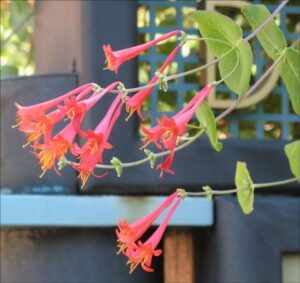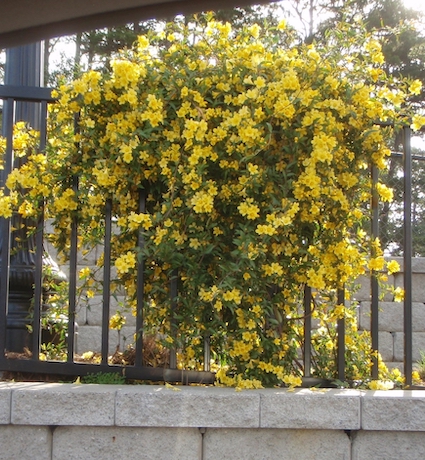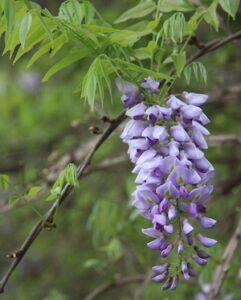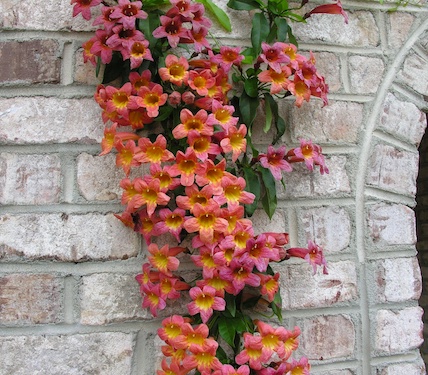Native Vines: Add Interest and Color in a Vertical Space
by Pat Dickey, Fairfax Master Gardener

Trumpet Honeysuckle
Vines are often underused as gardening elements. However, with the recent renewed interest in native plants, native vines can provide decorative and functional uses in any landscape. They have unique foliage, showy flowers, fruits for visual interest and fall color. They can soften unsightly architectural elements, offer shade to patios and porches and can be important in supporting steep embankments while preserving soil integrity.
It is important to select green material when designing a landscape that will not damage old buildings covered in brick. English ivy, for example, has resulted in damage to historic buildings because of the glue-like substance it secretes. Native vines can be grown as ‘green walls’ that will absorb sunlight, insulate the front of buildings, and reduce overall energy consumption within homes.
When designing the landscape of a home, it is important to consider vertical elements. Native vines can conceal the unsightly appearance of chain link fences and masonry on the side of buildings. They can also screen unsightly views or divide a yard into separate areas with the use of trellises and other supports. Vertical gardening can maximize the gardening area of a townhouse or small home. Native vines can be wrapped around light posts and stair railings to add flowers for hummingbirds, butterflies and pollinators.
Here is a list of native vines that you may want to try in your garden.

Yellow Jessamine
Yellow Jessamine (Gelsemium sempervirens) is a twining vine that has a modest growth rate up to 20 feet. It is showy and evergreen with yellow tubular flowers that are fragrant. It attracts hummingbirds and swallowtail butterflies. It enjoys a sunny location and will grow on an arbor or on a trellis. If unsupported, it becomes a bushy groundcover.
Common Hops (Humulus lupulus) is a 10 to 15 foot twining perennial vine that is dioecious (with male and female reproduction on separate plants). It is grown for the harvest of female fruits and is used to preserve and flavor beer. It can also be grown as an ornamental plant on wire, chain link fencing and other supports. Male flowers are showy on a small pendulous spike.
Riparian Grape (Vitis riparia) is a deciduous vine that climbs or trails 35 feet or more. Its fragrant flowers are small loose spikes of yellow-green, and its attractive exfoliating bark is reddish-brown. Bluish-black berries are eaten by birds and small mammals and can be made into jam or jelly. Their unpleasant acidic taste isn’t suitable for wine.

American Wisteria
American Wisteria (Wisteria frutescens) is a high climbing and woody deciduous vine that grows 25 to 30 feet with shiny dark green leaves. Its drooping flowers are in large clusters 6 to 9 inches long. The 1-inch long blooms only appear on new wood and are lilac or bluish purple and fragrant. This vine is less aggressive than the Asian species and can be used for ornamental planting.
Northern Leatherflower (Clematis viorna) has attractive lavender-purple bell or urn-shaped flowers that bloom in the spring until fall. Its flowers are favorites of butterflies, bees and hummingbirds. Larvae from butterflies, moths and flies feed on its foliage and stems. Plant it next to a trellis or spread it to grow over the ground. It also makes a good privacy screen.
Coral or Trumpet Honeysuckle (Lonicera sempervirens) is a twining vine that grows 10 to 20 feet tall. It needs a support structure or can grow across the ground as a groundcover. Trumpet-shaped orange-scarlet flowers bloom in the summer and fall but are not fragrant. Makes a great addition for a butterfly, native or pollinator garden.
Pipevine or Dutchman’s Pipe (Aristolochia macrophyllum) is a 20 to 25 foot deciduous vine, with twining stems and heart-shaped leaves. Flowers are pipe-shaped, mottled-green and burgundy, with yellow tubes. Plant 1 to 2 feet apart for screening. It is the larval host of the pipevine swallowtail.

Crossvine
Crossvine (Bignonia capreolata) is an evergreen vine with glossy leaves and orange-red trumpet flowers that hang in clusters. It climbs to 50 feet and attracts hummingbirds and butterflies. Its tendrils will cling to stone, brick and fences.
Virgin’s Bower (Clematis virginiana) climbs 15 to 20 feet through open shrubs by means of twisted stems or petioles that wrap around other plants. It blooms in August with small white cross-shaped flowers. Split rail fences or trellises will provide support.
Purple Passion Flower (Passiflora incarnata) is a trailing vine with axillary tendrils that rapidly grows to 25 feet. It will spread by root suckers and will cover large areas but does not climb. It has 3-inch showy purple flowers and orange-yellow edible berries and can be enjoyed in a children’s garden on a support or on a wall near a patio.
For more photos of native vines, see Fairfax Master Gardeners Instagram.
Resources
Choose Native Plants for Vining Green Walls, Mt Cuba Center
Vines, University of Maryland Extension
Designing with Vines, Robert F. Brzuszek, Mississippi State University Extension